All About Pink and Purple Sea Glass
The magic – and – mystery of pink and purple sea glass is captivating…
 It might be hard to find pink or purple sea glass against the blushing tones of the shells and sand that cover the shore... except that, in my experience, you usually find these colors on the beaches of Northern California where the sand is dark and pebbly, however, the Caribbean beaches where these colors are also found are a different story.
It might be hard to find pink or purple sea glass against the blushing tones of the shells and sand that cover the shore... except that, in my experience, you usually find these colors on the beaches of Northern California where the sand is dark and pebbly, however, the Caribbean beaches where these colors are also found are a different story.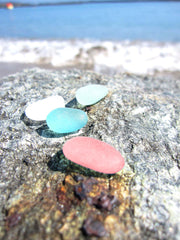 Among sea glass, pink and purple hues are the pastel darlings! Pink usually ranges from the palest ice pink to a lovely coral hue… true bright pink, like true bright purple, are ultra rare.
Among sea glass, pink and purple hues are the pastel darlings! Pink usually ranges from the palest ice pink to a lovely coral hue… true bright pink, like true bright purple, are ultra rare.
Most purple sea glass is actually “sun” purple – in the old days manganese was added to glass as a clarifying agent, and manganese turns purple when exposed to UV rays – like those in sunlight. That’s why some antique bottles have that lovely lavender glow… but more on that below!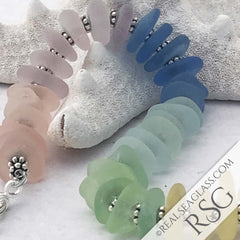 So, how is pink glass created? Just like manganese, selenium can be added to glass in tiny amounts to clarify it (make it more clear and colorless). But in larger amounts it can give glass that blushing, rosey color. Add even more and you get brilliant red. And, of course, gold was added to glass (and still sometimes is) to create a lovely raspberry color. Add more? You guessed it – deep ruby red.
So, how is pink glass created? Just like manganese, selenium can be added to glass in tiny amounts to clarify it (make it more clear and colorless). But in larger amounts it can give glass that blushing, rosey color. Add even more and you get brilliant red. And, of course, gold was added to glass (and still sometimes is) to create a lovely raspberry color. Add more? You guessed it – deep ruby red.
Beyond the beautiful lavender to purple “sun” purple tints, when you add more manganese, you get a bright to dark purple ranging into the very rare dark violet.
Pink Sea Glass
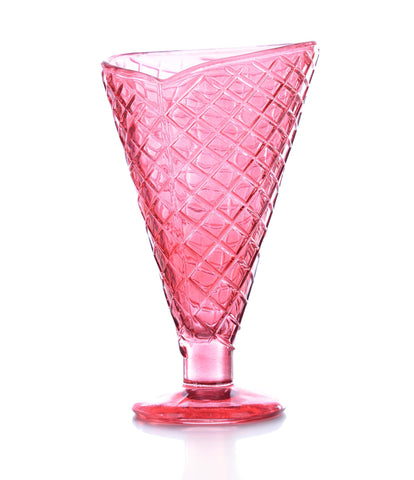 So, back in the dark days of the depression, American glass makers upped their production of pressed glass – dinnerware, serving pieces and knick-knacks were made in a host of colors from ambers and browns to rare UV and pink colors.
So, back in the dark days of the depression, American glass makers upped their production of pressed glass – dinnerware, serving pieces and knick-knacks were made in a host of colors from ambers and browns to rare UV and pink colors.
Five cents could buy a pretty piece pink glass in patters like Wild Rose, Flamingo, Princess, Tea Room, Royal Lace or American Sweetheart. For a homemaker trying to pinch every penny, the intricate patterns and soft sunset pink color provided something beautiful for just pennies a piece. Movie theaters, carnivals, and even cereal manufacturers used these glass pieces as premiums – your movie ticket came with the next piece for your collection! And, occasionally, these pieces broke and were discarded. It is from this historic Depression Era glass that most of our pink sea glass comes from. Sea glass in pale pinks and corals tend to come from tableware that was popular between 1915 and 1950. Deeper tones might come from thicker objects, like vases, cake plates and paperweights. The majority of pink sea glass has a light, peachy color. Deeper tones can come from cranberry glass. This reddish color has a fuchsia tone and is sometimes mistaken for red sea glass.
And, occasionally, these pieces broke and were discarded. It is from this historic Depression Era glass that most of our pink sea glass comes from. Sea glass in pale pinks and corals tend to come from tableware that was popular between 1915 and 1950. Deeper tones might come from thicker objects, like vases, cake plates and paperweights. The majority of pink sea glass has a light, peachy color. Deeper tones can come from cranberry glass. This reddish color has a fuchsia tone and is sometimes mistaken for red sea glass. Ironically… the once cheap pink glass is now by far the most valuable of all Depression era glass produced. I love to think that these softly glowing pieces of sea glass were a piece of glassware that once helped brighten the days of people who were experiencing extreme hardship. Now, like then, we love the gentle-hued pink glass that disperses sunlight with its own cheerful tone. Pink sea glass complements every skin tone – I just wish more of it was found, but it is a rare treasure.
Ironically… the once cheap pink glass is now by far the most valuable of all Depression era glass produced. I love to think that these softly glowing pieces of sea glass were a piece of glassware that once helped brighten the days of people who were experiencing extreme hardship. Now, like then, we love the gentle-hued pink glass that disperses sunlight with its own cheerful tone. Pink sea glass complements every skin tone – I just wish more of it was found, but it is a rare treasure.
Pink Sea Glass – Five Fascinating Facts
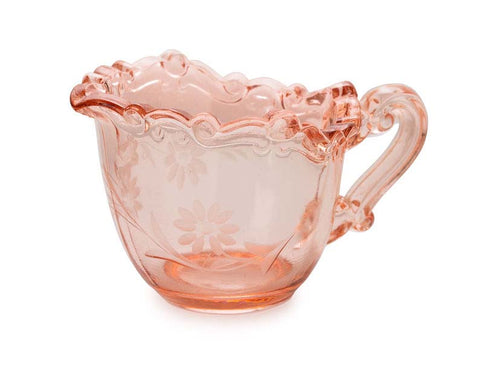 1. When it comes to collecting Depression Era pink sea glass, you’re more likely to have a piece from a cup than a saucer. There are three times as many intact vintage saucers than cups!
1. When it comes to collecting Depression Era pink sea glass, you’re more likely to have a piece from a cup than a saucer. There are three times as many intact vintage saucers than cups!
2. Because Depression Era glass tended to be thin, pink sea glass is often perfectly flat.
3. There were 20 manufacturers producing well over 100 patterns of pressed glass during the Depression – sometimes sea glass is found with remnants of these deeply pressed patterns!
4. In the 1940s you could find a pink plate at the thrift store for not much more than the original five cent asking price – now rarer pink Depression glass items go for over $500 each.
5. Not that you’d want to, but you can’t put Depression glass in the microwave. It is not heat proof or tempered in any way.
Pink Sea Glass Jewelry
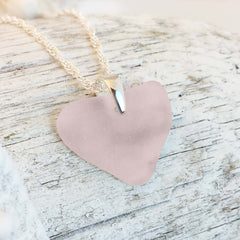 Pink – the color of romance! Long associated with love, pink is also playful, friendly, fun and open. Pink is associated with nurturing, affection and kindness.
Pink – the color of romance! Long associated with love, pink is also playful, friendly, fun and open. Pink is associated with nurturing, affection and kindness.
Wearing pink is said to increase one’s grace and charm, as well as generosity. It heightens your emotional awareness and increases optimism.
Reach for pink sea glass jewelry when you want to feel cheerful, healthy, energetic and hopeful. Wearing pink sea glass encourages creativity and action… and evokes sweet memories and happiness.
Purple Sea Glass
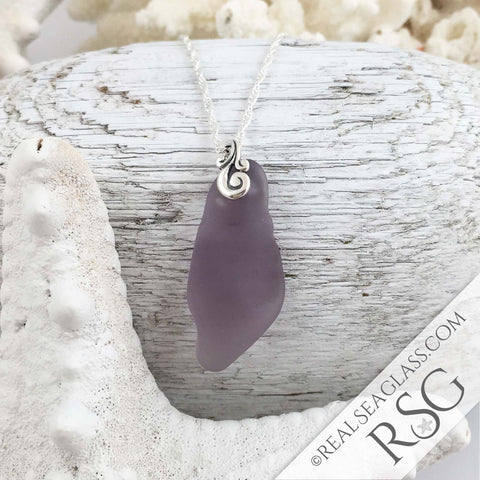 I just took you back to the Great Depression with pink glass… now I’m taking you all the way back to Ancient Egypt! For it was in this far-off land, thousands of years ago, that manganese was first used to produce purple glass. Not bad, considering glass making was in its infancy!
I just took you back to the Great Depression with pink glass… now I’m taking you all the way back to Ancient Egypt! For it was in this far-off land, thousands of years ago, that manganese was first used to produce purple glass. Not bad, considering glass making was in its infancy!
Sea glass that started out as deep purple glass most likely originates from glassware manufactured between the 1840s and 1880s, according to the Society for Historical Archaeology. Toward the latter end of that period, hair tonics were commonly sold in dark amethyst bottles. Flasks, ink bottles and bitters bottles might also have been tinted with a deep, purplish-burgundy hue. True dark purple glass is made with the same manganese that gives sun purple its lavender hue. But there are endless variations in purple glass, from almost black to the lightest of lavenders. Collectors classify purple glass by name, depending on the intensity of the hue. Here are just a few of those names: Deep Purple, Amethyst, Plum, Violet, Lilac, Grape, Eggplant and Royal Purple.
True dark purple glass is made with the same manganese that gives sun purple its lavender hue. But there are endless variations in purple glass, from almost black to the lightest of lavenders. Collectors classify purple glass by name, depending on the intensity of the hue. Here are just a few of those names: Deep Purple, Amethyst, Plum, Violet, Lilac, Grape, Eggplant and Royal Purple.
No matter what you call it, purple sea glass is rare and lovely. The frosting and micro-pitting of the surface give purple sea glass a wonderful, heathered appearance unlike any other color.
Sun Purple Sea Glass
 So, way back in the 1400s (we are all over history with this one), Venetian glass makers had a problem. Well, it was really the same problem that glassmakers throughout time had had. The inevitable iron impurities in the sand used to make glass turned the glass an aqua hue. (Yep, those lovely antique aqua bottles we love are that color because it was cheaper to not deal with the impurities in the sand used to make them.)
So, way back in the 1400s (we are all over history with this one), Venetian glass makers had a problem. Well, it was really the same problem that glassmakers throughout time had had. The inevitable iron impurities in the sand used to make glass turned the glass an aqua hue. (Yep, those lovely antique aqua bottles we love are that color because it was cheaper to not deal with the impurities in the sand used to make them.)
But the glassmakers of Venice wanted to create clear glass… and create it they did. They discovered that putting a small amount of manganese in the glass clarified it – decolorizing the glass and giving them the coveted clear glass!
By the nineteenth century, almost all glass was made with manganese dioxide. This element helped to remove the green tint from the final product. Adding manganese resulted in a crystal-clear glass because it neutralized the iron oxide that might be lurking in the sand.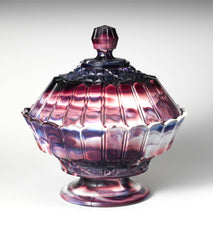 However, what those crafty Venetians didn’t know at the time of their discovery was that, over time, manganese glass turns purple as it’s exposed to ultraviolet rays. Experts still aren’t quite sure of the exact cause of this phenomenon. However, they believe that it has something to do with an exchange of electrons between the manganese and iron molecules in the glass.
However, what those crafty Venetians didn’t know at the time of their discovery was that, over time, manganese glass turns purple as it’s exposed to ultraviolet rays. Experts still aren’t quite sure of the exact cause of this phenomenon. However, they believe that it has something to do with an exchange of electrons between the manganese and iron molecules in the glass.
Manganese was used in glass until about 1920, when glass manufactures switched to a more effective decolorizer – selenium. And, yes, selenium turns a color when exposed to UV light… yellow – purple’s exact opposite on the color wheel. Hum…
So, if you find a light purple or pink piece of sea glass, it might be sun purple glass that has spent quite a bit of time basking in the sun. And it’s almost guaranteed you have a piece of glass that has hit, or is about to hit, that 100-year birthday!
Purple Sea Glass – Five Fascinating Facts
 1. Unscrupulous bottle sellers irradiate old bottles to darken their lavender tone to deep purple. Sun purple glass that is purpled naturally is rarely purple, it is almost always in the lavender range.
1. Unscrupulous bottle sellers irradiate old bottles to darken their lavender tone to deep purple. Sun purple glass that is purpled naturally is rarely purple, it is almost always in the lavender range.
2. The amount of manganese determines a purple sea glass shard’s ultimate ability to turn purple – the more manganese, the more purple it may become over time.
3. Archeologists use a glass shard’s purple tint to date pre-WWI bottle fragments!
4. Some of the most lovely pieces of sun purple glass I’ve seen are old glass insulators from the 1880’s. I collect these and my purples are a favorite!
5. Purple sea glass is one of the easiest colors to date. See that lovely lavender glow – almost guaranteed the glass harkens back to 1880 – 1920.
Purple Sea Glass Jewelry
 Purple is the color of magic and mystery. It is also the color of royalty! Purple is the perfect blend of the passion and energy of red, and the stability and confidence of blue.
Purple is the color of magic and mystery. It is also the color of royalty! Purple is the perfect blend of the passion and energy of red, and the stability and confidence of blue.
Said to convey a feeling of wealth and extravagance, purple is also the color of creativity, dignity, wisdom and independence. Throughout time, purple has been used for its ability to clarify thoughts and restore balance.
Wearing purple sea glass jewelry can help you connect with your intuition and imagination. Purple aids in overcoming adversity and keeping the faith.
Is Purple and Pink Sea Glass Rare?
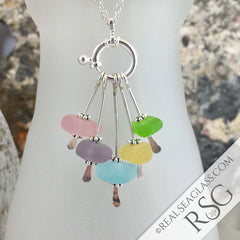 Yes! Deeper and more vibrant shades are ultra rare, but all sea glass in this color family is quite rare. A note of caution here: more and more manufacturers and jewelry makers are producing cheap frosted glass beads and passing them off as sea glass.
Yes! Deeper and more vibrant shades are ultra rare, but all sea glass in this color family is quite rare. A note of caution here: more and more manufacturers and jewelry makers are producing cheap frosted glass beads and passing them off as sea glass.
Real sea glass isn’t always perfect (although I think its imperfections make it perfect). Real sea glass has been worn by nature and, in the case of sun purple, kissed by the sun.  There is no technology advanced enough to replicate these features accurately. Genuine sea glass jewelry is produced by the elements and gathered by hand – and whispers of time and stories of days gone by.
There is no technology advanced enough to replicate these features accurately. Genuine sea glass jewelry is produced by the elements and gathered by hand – and whispers of time and stories of days gone by.
Pink and purple sea glass captures the magic of the beach - these delicate tones capture the beauty of a seashell and conjure the image of the beach at sunrise.
With its dreamy quality, and its kinship with scattered shells on the beach, discovering one of these rare gems is wonderful – wearing one is even better!




